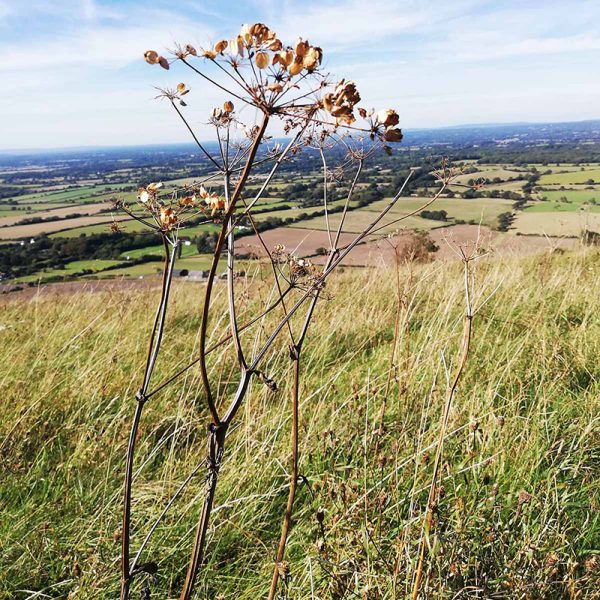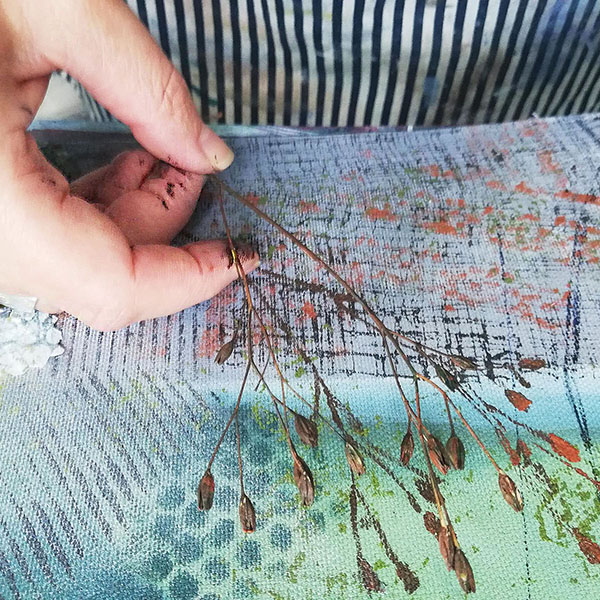
Six easy ways to find art inspiration in nature

Does being in nature make your heart sing?
Are you seeking ways to truly connect with nature and find inspiration for your art?
These six exercises will allow you to tune into the colours, shapes and textures of the outside world.
Whenever I try them, I come away filled with ideas, and with a sense of creative possibility.
I’m excited for you to experience this too.
First, find nature wherever you are
Whether you live in a rural idyll or on a busy urban street, there’s always greenery and stimulation to be found if you look for it.
It could be a local park, a beautifully tree-lined street or your own garden, if you have one. Just get out and explore.
If you do have easy access to the countryside, don’t let a busy life keep you indoors. Plan a walk – whether on your own or with friends – and enjoy the expansive views, the changing scenery and fresh air.
Once you’re out, wherever it may be, have a go at these six different exercises, and tap into nature’s rich seam of art inspiration.


1. Re-live your childhood and go on a treasure hunt
Remember how a perfectly smooth pebble could feel like a precious jewel in your small hand? Or how even a really good stick just had to come home with you? And don’t get me started on the joy of conkers…
My first tip is to get back into that headspace.
Get out and enjoy collecting the natural objects you’re most drawn to.
Importantly, my advice is to forget, entirely, about your creative projects. Banish them from your mind. And simply notice what you find truly, compellingly beautiful.
Is it certain leaves or petals? Pine cones or driftwood?
Back at home, lay out what you’ve collected. Then spend some time thinking about what you like about them. Is it the shape? The colour? The texture? The solidity? Or transparency?
Make a note of what you learn and, only now, begin thinking about how you could represent these elements in your art, and what inspiration nature has given you.
2. Focus on colour… and take photos, photos, photos
Colour moves us all in different ways – our responses are instinctive. A combination I love might make you recoil!
Your job is to find out what moves you, whether it’s a blossoming cherry tree against a vibrant blue sky or the soft blue-grey of coastal grasses.
A favourite exercise of mine is to take my camera (usually my phone) out for a walk and focus solely on colour – nothing else.
Give it a try, in different settings and at varying times of day.
You can snap away, capturing colours and combinations that jump out at you. Of course, it doesn’t have to be in nature. It could be a bright yellow front door, or the rich burnt-red of a crumbling brick wall.
As you build up a folder of images, you’re likely to find themes emerging, in terms of the tones you’re drawn to.
Printing out a selection of photos to create a mood board is a brilliant way to get new colour palette inspiration.
A final stage is to notice whether there are colours you love, but that you don’t seem to use in your art. Could this be a new avenue to explore?


3. Engage all your senses
It’s not just our eyes that experience nature. Try closing them and standing in silence.
What do you hear? What do you smell? If you’re with family or friends, you can compare what each of you noticed.
Another option is to take off your shoes and walk barefoot, feeling the ground beneath you. Gently touch trees and plants as you go.
Again, note down anything that feels important to you. It all builds a fuller picture of the natural world we live in, and that we aim to capture as artists.
4. Tune in to your emotional response
When you’re in nature – particularly when you’re out of town and in the countryside – take a moment to notice how you feel. Are you energised or calm? Joyous or wistful?
Make a note of all the feelings you can identify.
Next, change your focus from how you feel to describing the view itself. Not in terms of the physical scene before you, but the atmosphere it conjures up.
Words that have come to me recently have been bright, crisp, misty, soft, luscious, vibrant and serene.
Keeping a note of all these words can inspire the mood and feeling of your next artwork.


5. Take a sketchbook
Given that you’ve found your way to the Flourish website, I’m assuming you’re interested in textile art.
Am I also right in thinking that you’re not so confident at drawing? More comfortable playing with fabrics and thread?
If that’s the case, let me urge you to get started with a sketchbook, if you haven’t already. The whole point is that it’s for practising. No one ever has to see what’s inside.
And, with this practice, you may find your skills improve. What’s more, your drawings can be a record of ideas, becoming inspiration for free motion embroidery (which I see as drawing with thread).
So, pop a sketchbook in your bag next time you’re heading out for a walk. Then find a comfortable spot to sit, enjoy a drink from your thermos and start sketching what you see.
6. Nature as materials
Who says you have to use a paintbrush?
Keep an eye out for natural finds that you can use in your mark-making, whether as a ‘quill’ dipped in paint, or for scratching into wet paint. You could create one-off imprints with monoprinting, or even stitch objects onto your fabric.
What marks, textures and effects can you create?
Using natural finds as your tools can add to your sense of truly working nature into your art.




